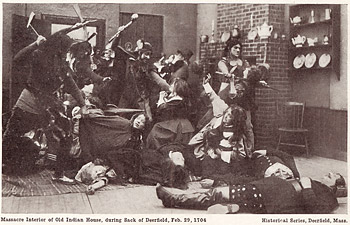Why Deerfield?
Films and Pageants, Portraying Colonial Heritage
A 'Great Moment in American History'
In March 1910, four months prior to Deerfield's first historical pageant and following a storm that blanketed the town in four feet of snow, the Edison Manufacturing Company arrived to capture many of the scenes for Ononko's Vow, part of Edison's "Great Moments in American History" series for which Christopher Columbus had been released in 1904. The silent film was written by Greenfield, Massachusetts theatre owner, Herbert S. Streeter. It brings to life a tale, that George Sheldon recounts to tourists in the opening scene, of the lasting loyalty of one native father and his son to a Deerfield family, in the face of periodic French and Indian raids, a reality on the seventeenth-century frontier of western Massachusetts. How did this piece of historical fiction appeal to movie goers in 1910? A local reporter believed that knowing what to leave out was as important as choosing what to put in:
History has a strong appeal to motion picture audiences, provided it is selected...with a view to leaving out the dry parts....Indians with their hatchets, tomahawks, bows and arrows, war paint and feathers are just the people to turn loose upon a picture screen if you would make the audience sit up and give attention.1
- "New Attack on Deerfield by Moving Picture Red Skins," Springfield Republican March 13, 1910, p. 15.
 In Their Words
In Their Words
 Comparisons
Comparisons

© Memorial Hall Museum, Pocumtuck Valley Memorial Association
Postcard with scene from "Ononko's Vow"
Edison Manufacturing Company, 1910.


















